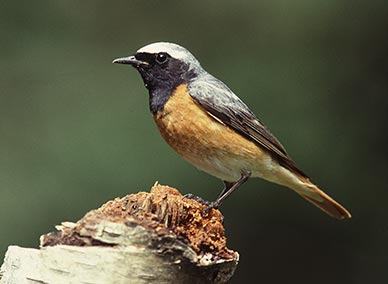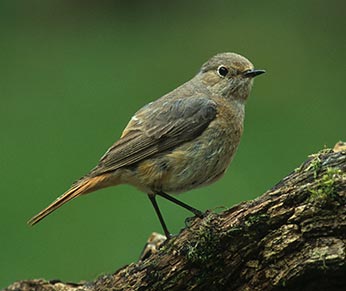Redstart (Phoenicurus phoenicurus)
When: From late-March to September
How many: Quite common / widespread

It’s dawn in the New Forest, the start of a beautiful day in early-May, and a redstart is singing from on high in an ancient pollard beech, a sight and sound as characteristic of these old woodlands as the ponies and wild deer that quietly browse the hollies.
Redstarts are summer visitors to the New Forest, arriving from Africa to breed from late March onwards, and heading south again by September.
Redstart song is often the first indication of presence, although it is really nothing more than a hurried snatch of notes that peter out into a tinny jangle.
Male redstarts are one of the New Forest’s most colourful birds, but they can be incredibly difficult to locate when high in the canopy, seemingly always with trunk, bough or foliage between themselves and the observer. Plumage is a rich mixture of orange, grey, black and white, whilst the more subtly coloured females are grey-brown, suffused on the breast with the merest hint of orange.
Redstart body shape, particularly of the female, is at times reminiscent of that of a robin, to which the redstart is closely related. Both sexes have a constantly shivering, resplendent orange-red tail that gives the bird its name - staert is old English for tail. In parts of Hampshire, though, they were also known as firetails, and that, of course, is equally appropriate.

In the New Forest, redstarts are most abundant in unenclosed woodlands used by commoners’ stock and deer. Redstarts do, though, also occur in many of the broad-leaved inclosures, but overgrown woodland is often ignored.
Habitat selection is strongly associated with the redstart's preferred hunting methods, for whilst insects high in the woodland canopy and in flight are taken, redstarts like to search for invertebrates on bare or sparsely vegetated ground. They either pick amongst the leaf litter, or use low perches from which to swoop, returning back to the perch to devour their catch before again repeating the process.
National redstart distribution is largely northerly and westerly, centred particularly on the thinly vegetated upland woods of Dartmoor, Exmoor, Wales, Scotland, the Pennines and the Lake District.
The availability of dead and decaying timber is also an important factor in the redstarts’ choice of home, for in the New Forest they are primarily hole-nesters that use natural cavities, usually quite low down in the trunks of broad-leaved trees.
A loose cup of grass, moss and other vegetation is placed within the cavity and lined with hair and feathers. Five to seven eggs are usually laid, and two broods are often raised.
References:
The Shell Guide to the Birds of Britain and Ireland: James Ferguson-Lees, Ian Willis and J.T.R. Sharrock
The Birds of the Western Palearctic, Concise Edition: D.W. Snow and C.M. Perrins
The New Atlas of Breeding Birds in Britain and Ireland (1988-91): D.W. Gibbons, J.B. Reid and R.A. Chapman
The New Forest – A Natural History: Colin R. Tubbs
All the Birds of the Air: Francesca Greenoak
More links
Other related links
Search this site

Sadly, 58 animals were killed - 35 ponies, 13 cows, 8 donkeys and 2 sheep, whilst a further 32 were injured - 3 pigs, 9 donkeys, 11 cows and 9 ponies.
(Forty-three accidents occurred in daylight, 15 at twilight and 101 in the dark. Twenty-seven accidents were not reported by the driver involved).
Here's just one horrific example - Three donkeys killed in collision with van at notorious New Forest blackspot (Advertiser and Times)

